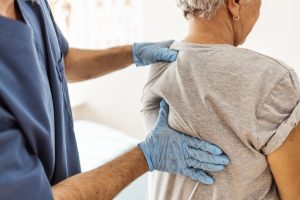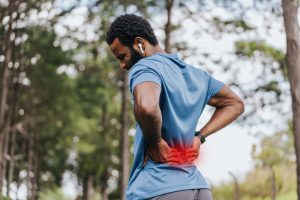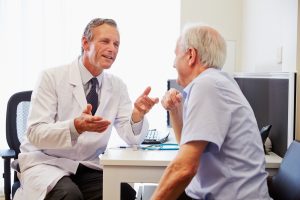Ankylosing Spondylitis
Ankylosing spondylitis is a disease that causes severe inflammation in the spinal joints. The term ankylosing refers to the stiffening or fusion of the bones while the term spondylitis is defined as an inflammatory disease affecting the spine. In severe cases of spondylitis, the joint damage can actually cause the spinal joints to fuse together.
Despite the fact that the condition has no known cure and the causes are unclear, treatment is available and has proven to be beneficial to patients.
Ankylosing Spondylitis Causes
Ankylosing spondylitis is an inflammatory form of arthritis that affects the spinal column and causes joint damage. Classified as an autoimmune disease, ankylosing spondylitis causes the body’s immune system to attack healthy cells in and around the spinal facet joints. The causes of ankylosing spondylitis are not fully understood but the presence of the genetic marker, HLA_B27, is believed to increase the risk of developing the condition.
Moreover, Ankylosing Spondylitis is more common in men and generally develops in the late teenage years and early adulthood. It is common for the symptoms of this condition to begin mildly and be confused with other conditions. Additionally, this condition worsens as time goes on.
Treatments
Doctors will initially perform typical back pain examinations and then move on to more specific measures. The doctor will ask about symptoms, activity, and review medical history, followed by asking the patient to perform movement tests and hands-on examinations. They will lastly order MRI and blood work in order to confirm or rule out the presence of other conditions or diseases.
Once the diagnosis of ankylosing spondylitis has been reached, a treatment plan must be developed. Although ankylosing spondylitis is not curable, there are steps that can be taken in order to manage symptoms and slow down the rate of joint damage and deformity.
Conservative Therapy/Lifestyle Considerations
It is recommended for patients to pursue a course of conservative therapy to relieve pain inflammation. This includes:
- Staying active and getting regular low-impact exercise
- Eating a nutrient-rich anti-inflammatory diet
- Avoid tobacco products
- Focus on good posture throughout the day
Symptoms
Initial symptoms of ankylosing spondylitis are typically back pain and stiffness but some cases have also reported neck and/or hip pain. Symptoms are generally more apparent in the mornings or after long periods of inactivity. It is common for patients with this condition to experience bouts or flare-ups of symptoms before going into remission.
Ankylosing spondylitis patients also report symptoms in the following areas:
- Sacroiliac joint
- Attachment joints for tendons and ligaments in the spine and other joints
- Cartilage in the ribs and sternum
- Shoulder joints
Proper diagnosis is critical for effective treatment. If you are experiencing aches, pains, or stiffness that lasts longer than a week, see a doctor for a diagnosis and treatment.
Spine Surgery
Spine surgery is, for the most part, not recommended for patients with ankylosing spondylitis. However, in some cases of severe spinal instability and/or nerve compression, a fusion or stabilization procedure may be needed to help reduce nerve compression and back pain as well as address the rate of spinal deformity. Furthermore, there are cases in which ankylosing spondylitis causes hip problems in which a hip replacement procedure may become necessary depending on the patient.
Reach Out to BEST Health System Today
Ankylosing spondylitis can be a difficult condition to live with, but it can be successfully managed. If you are seeking to maintain a healthy and active lifestyle after being diagnosed with ankylosing spondylitis, it is important to take a proactive approach to treatment. At BEST Health System, our multidisciplinary team has extensive experience in helping patients with a broad range of conditions find the relief they need for a good quality of life. From physical therapy to minimally invasive surgery, we’re committed to state of the art, patient centered care.
If you have experienced any of these symptoms or recieved a diagnosis and need treatment, BEST can help. Take the first step towards relief today.
Related Articles
Three Common Causes of a Degenerative Spine
Understanding Spine Conditions A degenerative spine is a condition that causes the structures of the spine, such as the vertebrae, joints, discs, muscles, and ligaments, […]
How To Know If I Have Neuropathy
Understanding Neuropathy Neuropathy, also known as nerve damage, is a common condition that affects a range of patients. When nerves are damaged, they cannot successfully […]
Avoiding Failed Back Surgery Syndrome
Pain After Spine Surgery Even though many neck and back surgeries are successful, some ultimately fail. Of the various causes of failed back surgery syndrome, […]
Safely Exercising with Chronic Pain
The Importance of Exercising for Chronic Pain Management Exercise is an essential part of maintaining good health and preventing health issues from occurring in the […]
Four Questions to Ask Your Doctor About Failed Back Surgery Syndrome
Understanding Failed Back Surgery Syndrome Failed back surgery syndrome treatment often varies from patient to patient depending on factors such as the specific cause of […]
Natural Remedies for Neuropathy Treatment
Understanding Common Neuropathy Symptoms Neuropathy manifests various symptoms – from tingling and numbness sensations to muscle weakness and balance difficulty. It is important for patients […]
Why You Shouldn't Ignore Post-Surgical Back Pain
Understanding the Causes of Post-Surgical Back Pain Immediately after spine surgery, pain is normal to an extent. In the days following, patients may experience stiffness […]
Tips for Traveling with Canal Stenosis
Understanding Canal Stenosis Canal stenosis, also known as spinal stenosis or central stenosis, is a condition characterized by the narrowing of a section of the […]
Understanding What Causes Failed Back Surgery Syndrome?
Understanding Failed Back Surgery Syndrome Failed back surgery syndrome can occur for several reasons. In some instances, there’s one, easy-to-identify issue, while in others, there’s […]
Diabetic Neuropathy Treatment Options
Living with Diabetic Neuropathy Painful diabetic neuropathy is a common condition that many diabetes patients suffer from. Neuropathy, commonly referred to as nerve damage, can […]
How Complex Regional Pain Syndrome Affects the Body
What is Complex Regional Pain Syndrome Complex regional pain syndrome, commonly referred to as CRPS, is a nerve-related condition that causes patients to experience debilitating […]
FAQs about Phantom Limb Pain
Understanding Phantom Limb Pain Phantom limb pain is a chronic condition that affects patients who have recently had an amputation. Patients with this condition often […]











